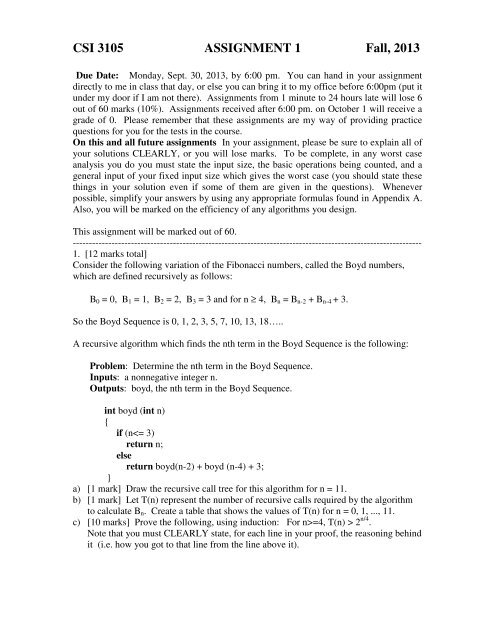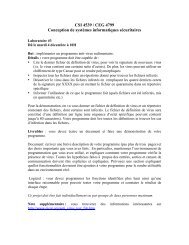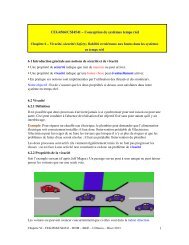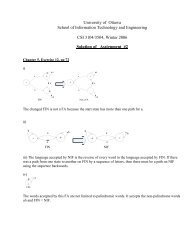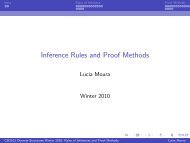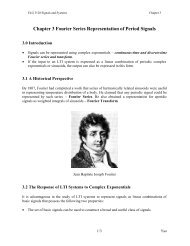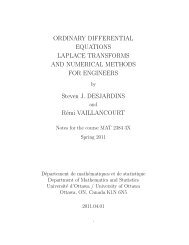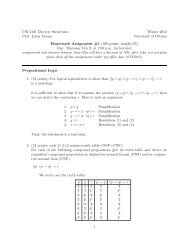CSI 3105 ASSIGNMENT 1 Fall, 2013
CSI 3105 ASSIGNMENT 1 Fall, 2013
CSI 3105 ASSIGNMENT 1 Fall, 2013
You also want an ePaper? Increase the reach of your titles
YUMPU automatically turns print PDFs into web optimized ePapers that Google loves.
<strong>CSI</strong> <strong>3105</strong> <strong>ASSIGNMENT</strong> 1 <strong>Fall</strong>, <strong>2013</strong><br />
Due Date: Monday, Sept. 30, <strong>2013</strong>, by 6:00 pm. You can hand in your assignment<br />
directly to me in class that day, or else you can bring it to my office before 6:00pm (put it<br />
under my door if I am not there). Assignments from 1 minute to 24 hours late will lose 6<br />
out of 60 marks (10%). Assignments received after 6:00 pm. on October 1 will receive a<br />
grade of 0. Please remember that these assignments are my way of providing practice<br />
questions for you for the tests in the course.<br />
On this and all future assignments In your assignment, please be sure to explain all of<br />
your solutions CLEARLY, or you will lose marks. To be complete, in any worst case<br />
analysis you do you must state the input size, the basic operations being counted, and a<br />
general input of your fixed input size which gives the worst case (you should state these<br />
things in your solution even if some of them are given in the questions). Whenever<br />
possible, simplify your answers by using any appropriate formulas found in Appendix A.<br />
Also, you will be marked on the efficiency of any algorithms you design.<br />
This assignment will be marked out of 60.<br />
------------------------------------------------------------------------------------------------------------<br />
1. [12 marks total]<br />
Consider the following variation of the Fibonacci numbers, called the Boyd numbers,<br />
which are defined recursively as follows:<br />
B 0 = 0, B 1 = 1, B 2 = 2, B 3 = 3 and for n ≥ 4, B n = B n-2 + B n-4 + 3.<br />
So the Boyd Sequence is 0, 1, 2, 3, 5, 7, 10, 13, 18…..<br />
A recursive algorithm which finds the nth term in the Boyd Sequence is the following:<br />
Problem: Determine the nth term in the Boyd Sequence.<br />
Inputs: a nonnegative integer n.<br />
Outputs: boyd, the nth term in the Boyd Sequence.<br />
int boyd (int n)<br />
{<br />
if (n=4, T(n) > 2 n/4 .<br />
Note that you must CLEARLY state, for each line in your proof, the reasoning behind<br />
it (i.e. how you got to that line from the line above it).
2.[5 marks] Write an iterative algorithm (using the same sort of C++-like pseudocode<br />
used in the text) for finding the nth term in the Boyd Sequence which is much more<br />
efficient than the algorithm in question 1. Do a worst-case analysis of your algorithm in<br />
which you count the number of additions and subtractions (but do not count additions or<br />
subtractions that are increments of a loop counter).<br />
3. [8 marks total, 4 marks each]<br />
For each of the following inputs, calculate the exact number of comparisons of x with<br />
keys in S for the iterative version of binary search (Alg. 1.5). For each iteration of the<br />
algorithm, show the values of high, low and mid (so it is easy for us to check your<br />
answer). For both examples, compare the number you get to the number of comparisons<br />
in the worst case for this value of n, using the exact formula for W(n) we found in class.<br />
Is the number of comparisons the same or less than the worst case number? (If you get a<br />
number that is larger, you had better check it!).<br />
a) n = 8, x = 10 (i.e. x is not in S, and is between the first and second number in S),<br />
S = [8, 14, 23, 29, 30, 32, 36, 45]<br />
b) n = 8, x = 37 (i.e. x is not in S, and x is between the last two numbers in S), and<br />
S = [7, 14, 23, 25, 30, 32, 35, 40]<br />
4. [10 marks total, 5 marks each]<br />
Do a worst-case analysis for the following algorithm segments, counting the number of<br />
multiplications which occur. (I have marked the lines with the multiplications you are to<br />
count with {****}). For all of these algorithms, use n as your fixed input size (even<br />
though n doesn’t really represent the “size” of the input). Be sure to include detailed<br />
explanations with your answers.<br />
a) answer = 25;<br />
for (i = 1; i
5. [15 marks total]<br />
a) [10 marks]<br />
Consider the following problem. You are given an array S of n numbers (unsorted), and<br />
you are given a value K. You wish to rearrange S such that all the numbers


